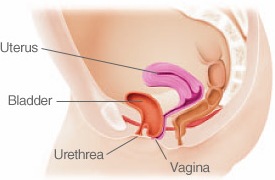Owing to the fact that the organs of the pelvic region are interconnected, one may acquire more than one prolapse.
The prolapse can develop in several different muscles and organs of pelvic region.
Depending on the area affected, the type of pelvic organ prolapse is determined.
Know The Classification Of Pelvic Organ Prolapse:
The prolapse types are classified into three categories.
Anterior Wall Of The Vagina
Cystocele: Also known as bladder prolapse or bladder drop. It is a very common type of prolapse of the vagina. It develops with the prolapse of the anterior wall of the vagina that connects the vagina and the bladder.
With this, the bladder fails support and descents into the vagina creating a huge swelling in the anterior wall of the vagina. A cystocele can be mild, severe or complicate.
Bladder prolapse in its mild form descends slightly into the vagina. In its severe form, the bladder comes down much extent near the opening of the vagina. In complicated/more advanced form, the bladder protrudes out of the vaginal opening.
Urethrocele: It is the prolapse of the urethra. This develops with the prolapse of the front wall of the vagina. This makes the ligaments of the vagina that supports the urethra become weak and allows the urethra to slip down. This type of prolapse also occurs along with the cystocele and the condition is known as cystourethrocele.
Posterior Wall Of The Vagina
Enterocel: It is also known as herniated small bowel. This type of prolapse develops with partition of the front and back walls of the vagina and weakening of the vaginal support.
As a result, the small intestine presses against the vaginal skin and descend in the middle of the rectum and the posterior vaginal wall. Although it is a rare prolapse, it is more common in women who had a hysterectomy.
Rectocele: It is the prolapse of the rectal wall. It develops with the weakening of the tissues and muscles that support the end of the large intestine (rectum). This allows the large bowel to press against the posterior vaginal wall and bulges.
Apical Of The Vagina
Uterine Prolapse: It is also known as uterine descensus. It develops when the uterosacral ligaments, the ligaments that support the top of the vagina weakens. It also weakens the anterior and posterior walls of the vagina. As a result, the uterus falls into the vagina.
Uterine prolapse undergoes several stages. In the initial stage, the uterus slips down slightly into the upper part of the vagina. Following this stage, the uterus moves far enough into the lower portion of the vagina. In the next stage, the uterus bulges out through the vagina and the cervix. In the final stage, the uterus obtrudes completely out of the vagina.
Vaginal vault prolapse: It is the prolapse of the vaginal vault, the top of the vagina. It mostly occurs in women who had the removal of the uterus (hysterectomy).
As the uterus supports the vaginal vault, its removal allows the vaginal vault to fall towards the vaginal opening. The uterus removal can also result in weakening of vagina and allows the vaginal vault to move out of the body from the opening of the vagina.






